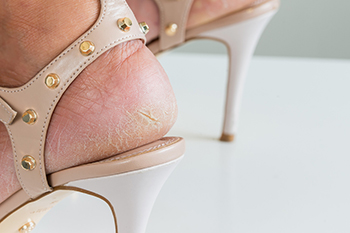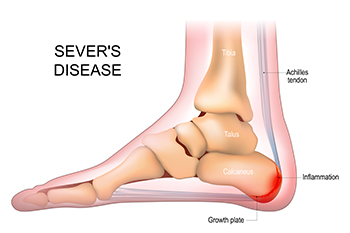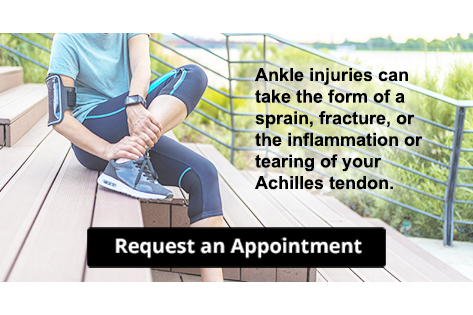Items filtered by date: October 2023
Seeing a Podiatrist for Cracked Heels

An individual would see a podiatrist for cracked heels because they are specialists in foot and ankle care, and cracked heels can be more than just a cosmetic issue. While minor heel fissures may be seen as a nuisance, severe cracks can be painful, bleed, or become infected. A podiatrist can identify the underlying causes of cracked heels, which may include biomechanical issues, skin conditions, systemic diseases, or prolonged pressure. This foot doctor can provide professional treatments such as debridement, where the hard, dead skin is removed safely, and prescribe specialized moisturizers or medicated creams. Additionally, they can offer guidance on footwear choices, recommend orthotic inserts to redistribute pressure, and offer advice on preventive measures. If you have persistent or severe cracked heels, it is suggested that you make an appointment with a podiatrist to ensure they are cared for and to avoid complications.
Cracked heels are unsightly and can cause further damage to your shoes and feet. If you have any concerns, contact Franklin Harry, DPM from Best Foot Forward. Our doctor can provide the care you need to keep you pain-free and on your feet.
Cracked Heels
Cracked heels appear unappealing and can make it harder for you walk around in sandals. Aside from looking unpleasant, cracked heels can also tear stockings, socks, and wear out your shoes. There are several methods to help restore a cracked heel and prevent further damage.
How Do You Get Them?
Dry skin is the number one culprit in creating cracked heels. Many athletes, walkers, joggers, and even swimmers suffer from cracked heels. Age and skin oil production play a role to getting cracked heels as well.
Promote Healing
Over the counter medicines can help, especially for those that need instant relief or who suffer from chronic dry feet.
Wear Socks – Wearing socks with medicated creams helps lock in moisture.
Moisturizers – Applying both day and night will help alleviate dryness which causes cracking.
Pumice Stones – These exfoliate and remove dead skin, which allows for smoother moisturizer application and better absorption into the skin.
Change in Diet
Eating healthy with a well-balanced diet will give the skin a fresh and radiant look. Your body responds to the kinds of food you ingest. Omega-3 fatty acids and zinc supplements can also revitalize skin tissue.
Most importantly, seek professional help if unsure how to proceed in treating cracked heels. A podiatrist will help you with any questions or information needed.
If you have any questions, please feel free to contact our offices located in Festus and St. Louis, MO . We offer the newest diagnostic and treatment technologies for all your foot care needs.
Foot Deformities in Newborns

The most common deformities in newborns are metatarsus adductus and calcaneovalgus, both of which typically resolve without long-term complications. Metatarsus adductus involves a curve in the middle of the baby's foot, causing it to fold inward. The key question is whether the foot is flexible and can be gently straightened. In most cases, flexible metatarsus adductus corrects itself by 6 to 12 months of age. Clubfoot is also recognizable by a stiff foot with a high arch. It can occur in one or both feet and may be detected before birth via prenatal ultrasound. The Ponseti method, involving casting, Achilles tenotomy, and bracing, is highly effective if initiated within the first few weeks after birth. Congenital vertical talus results in an upward and outward bend in the foot, similar to clubfoot. It's typically stiff and uncorrectable, requiring surgery and casting. Calcaneovalgus presents as the opposite of metatarsus adductus, with the foot pushed upward and outward. This condition often resolves naturally within a few months. Surgery is rare, except when there's significant shin bone bowing. If you have concerns about your newborn's foot alignment, it is suggested that you consult a podiatrist for expert guidance and appropriate care.
Congenital foot problems require immediate attention to avoid future complications. If you have any concerns, contact Franklin Harry, DPM of Best Foot Forward. Our doctor can provide the care you need to keep you pain-free and on your feet.
Congenital foot problems are deformities affecting the feet, toes, and/or ankles that children are born with. Some of these conditions have a genetic cause while others just happen. Some specific foot ailments that children may be born with include clubfeet, polydactyly/macrodactyly, and cleft foot. There are several other foot anomalies that can occur congenitally. What all of these conditions have in common is that a child may experience difficulty walking or performing everyday activities, as well as trouble finding footwear that fits their foot deformity. Some of these conditions are more serious than others. Consulting with a podiatrist as early as possible will help in properly diagnosing a child’s foot condition while getting the necessary treatment underway.
What are Causes of Congenital Foot Problem?
A congenital foot problem is one that happens to a child at birth. These conditions can be caused by a genetic predisposition, developmental or positional abnormalities during gestation, or with no known cause.
What are Symptoms of Congenital Foot Problems?
Symptoms vary by the congenital condition. Symptoms may consist of the following:
- Clubfoot, where tendons are shortened, bones are shaped differently, and the Achilles tendon is tight, causing the foot to point in and down. It is also possible for the soles of the feet to face each other.
- Polydactyly, which usually consists of a nubbin or small lump of tissue without a bone, a toe that is partially formed but has no joints, or an extra toe.
- Vertical talus, where the talus bone forms in the wrong position causing other bones in the foot to line up improperly, the front of the foot to point up, and the bottom of the foot to stiffen, with no arch, and to curve out.
- Tarsal coalition, when there is an abnormal connection of two or more bones in the foot leading to severe, rigid flatfoot.
- Cleft foot, where there are missing toes, a V-shaped cleft, and other anatomical differences.
- Macrodactyly, when the toes are abnormally large due to overgrowth of the underlying bone or soft tissue.
Treatment and Prevention
While there is nothing one can do to prevent congenital foot problems, raising awareness and receiving neonatal screenings are important. Early detection by taking your child to a podiatrist leads to the best outcome possible.
If you have any questions please feel free to contact our offices located in Festus and St. Louis, MO . We offer the newest diagnostic tools and technology to treat your foot and ankle needs.
Why Do I Have Foot Pain?

Foot pain is a common complaint that can have various origins, making it necessary to pinpoint the underlying cause for effective treatment. One common culprit is overuse or strain, often seen in athletes or individuals who spend long hours on their feet. Arthritis, both osteoarthritis and rheumatoid arthritis, can trigger pain by causing inflammation and joint damage in the feet. Footwear plays a significant role and wearing ill-fitting shoes or high heels can lead to pain and discomfort. Additionally, flat feet or high arches can cause biomechanical imbalances, leading to pain. Infections, such as athlete's foot or fungal nail infections, can be a source of discomfort. Nerve issues consisting of neuropathy, can also manifest as foot pain. Trauma or injuries, like sprains, fractures, or torn ligaments, require immediate attention. Diabetes related complications can contribute to nerve and circulation problems leading to chronic foot pain. Identifying the specific cause of foot pain is essential for targeted treatment and relief. If you have any type of foot pain, it is suggested that you make an appointment with a podiatrist who can determine what the cause is, and offer you correct treatment methods.
Foot Pain
Foot pain can be extremely painful and debilitating. If you have a foot pain, consult with Franklin Harry, DPM from Best Foot Forward. Our doctor will assess your condition and provide you with quality foot and ankle treatment.
Causes
Foot pain is a very broad condition that could be caused by one or more ailments. The most common include:
- Bunions
- Hammertoes
- Plantar Fasciitis
- Bone Spurs
- Corns
- Tarsal Tunnel Syndrome
- Ingrown Toenails
- Arthritis (such as Gout, Rheumatoid, and Osteoarthritis)
- Flat Feet
- Injury (from stress fractures, broken toe, foot, ankle, Achilles tendon ruptures, and sprains)
- And more
Diagnosis
To figure out the cause of foot pain, podiatrists utilize several different methods. This can range from simple visual inspections and sensation tests to X-rays and MRI scans. Prior medical history, family medical history, and any recent physical traumatic events will all be taken into consideration for a proper diagnosis.
Treatment
Treatment depends upon the cause of the foot pain. Whether it is resting, staying off the foot, or having surgery; podiatrists have a number of treatment options available for foot pain.
If you have any questions, please feel free to contact our offices located in Festus and St. Louis, MO . We offer the newest diagnostic and treatment technologies for all your foot care needs.
How Shoes Can Affect Your Foot Health

Proper footwear is essential for preventing various foot conditions and discomfort. Here are some key considerations to keep in mind when choosing your footwear. Those who stand for extended periods on hard surfaces like concrete may experience heel and forefoot pain and calluses and corns. Opt for supportive shoes with softer soles and arch support to alleviate these stresses. This helps distribute your weight more evenly and reduces pressure on the feet. If you have foot soreness, consider lace-up boots. These boots can help maintain leg alignment and distribute even pressure on the muscles and ligaments around your foot. While high heels may be fashionable, they can cause forefoot pressure and deformities. By limiting their use, you can promote better foot health. For those engaged in physical activities, look for shoes that provide cushioning for shock absorption during activities such as running and jumping. Flexibility at the ball of the foot and proper heel support are other essential features. For further help with taking care of your feet through appropriate footwear, it is suggested that you seek the help of a podiatrist.
Everyday foot care is very important to prevent infection and other foot ailments. If you need your feet checked, contact Franklin Harry, DPM from Best Foot Forward. Our doctor can provide the care you need to keep you pain-free and on your feet.
Everyday Foot Care
Often, people take care of their bodies, face and hair more so than they do for their feet. But the feet are a very important aspect of our bodies, and one that we should pay more attention to. Without our feet, we would not be able to perform most daily tasks.
It is best to check your feet regularly to make sure there are no new bruises or cuts that you may not have noticed before. For dry feet, moisturizer can easily be a remedy and can be applied as often as necessary to the affected areas. Wearing shoes that fit well can also help you maintain good foot health, as well as making it easier to walk and do daily activities without the stress or pain of ill-fitting shoes, high heels, or even flip flops. Wearing clean socks with closed shoes is important to ensure that sweat and bacteria do not accumulate within the shoe. Clean socks help to prevent Athlete’s foot, fungi problems, bad odors, and can absorb sweat.
If you have any questions please feel free to contact our offices located in Festus and St. Louis, MO . We offer the newest diagnostic and treatment technologies for all your foot and ankle needs.
Get Proper Treatment for Ankle Injuries
Definition and Causes of Sever’s Disease

Sever's disease, also known as calcaneal apophysitis, is a common but often misunderstood condition that affects growing children, particularly those involved in sports. The primary cause of Sever's disease is the rapid growth of bones in the feet during adolescence. This growth can outpace the development of the Achilles tendon, causing tension and irritation where the tendon attaches to the heel's growth plate. Symptoms typically include heel pain, which may be sharp, throbbing, or aching, especially during or after physical activities. The pain tends to worsen with pressure on the heel, especially during running or jumping. Children may also experience limping or discomfort while walking, particularly upon waking or after periods of rest. While Sever's disease is a self-limiting condition that resolves with time, it is a good idea to manage symptoms effectively. Adequate rest and performing gentle stretching exercises can help alleviate pain and promote healing. If your child complains of heel pain, it is suggested that you consult a podiatrist for guidance and to see if Sever's disease is causing the problem.
Sever's disease often occurs in children and teens. If your child is experiencing foot or ankle pain, see Franklin Harry, DPM from Best Foot Forward. Our doctor can treat your child’s foot and ankle needs.
Sever’s Disease
Sever’s disease is also known as calcaneal apophysitis, which is a medical condition that causes heel pain I none or both feet. The disease is known to affect children between the ages of 8 and 14.
Sever’s disease occurs when part of the child’s heel known as the growth plate (calcaneal epiphysis) is attached to the Achilles tendon. This area can suffer injury when the muscles and tendons of the growing foot do not keep pace with bone growth. Therefore, the constant pain which one experiences at the back of the heel will make the child unable to put any weight on the heel. The child is then forced to walk on their toes.
Symptoms
Acute pain – Pain associated with Sever’s disease is usually felt in the heel when the child engages in physical activity such as walking, jumping and or running.
Highly active – Children who are very active are among the most susceptible in experiencing Sever’s disease, because of the stress and tension placed on their feet.
If you have any questions, please feel free to contact our offices located in Festus and St. Louis, MO . We offer the newest diagnostic and treatment technologies for all your foot and ankle injuries.

